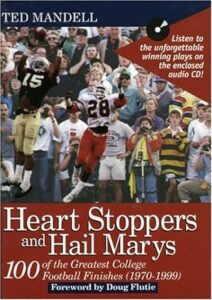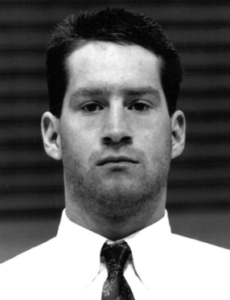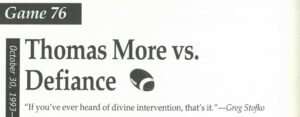By Raymond G. Hebert, Ph.D.
Thomas More University
In 2000 Ted Mandell, a Professor of Film, Television, and Theater at the University of Notre Dame, published a book entitled Heart Stoppers and Hail Marys: 100 of the Greatest College Football Finishes (1970–1999). It included a Foreword by the legendary Doug Flutie, who is said “to have deserved to own the patent on Hail Mary passes” (Mandell, p. xi). To the surprise of many, Game #76 in the book is Thomas More College vs. Defiance College, in Defiance, Ohio. The entry began with a quote from the eventual hero, Greg Stofko, who said: “If you’ve ever heard of divine intervention, that’s it” (Mandell, Thomas More vs. Defiance – Game 76,” pp. 252-254).

Ted Mandell’s Heart Stoppers and Hail Marys: 100 of the Greatest College Football Finishes (1970–1999) featured the October 30, 1993 Thomas More Football game against Defiance College. (Courtesy of Ted Mandell)
The day/week of this phenomenal play had begun with the 8-0 Defiance Yellow Jackets nationally ranked and #3 in the NCAA North Region. They had won 25 of 28 games in the previous three seasons but were after revenge since two of their three losses had been to Thomas More. The trash talk had started early after Thomas More’s disappointing loss two weeks before to the University of Wisconsin–Stevens Point in bad weather and on a controversial call to end the game. A bye-week would follow with time to remember but also to forget. This is the story of that week as well as that game, because they are so intertwined, as remembered by Professor of Philosophy George Blair and a number of others. Dr. Blair’s reminiscence is called: “Reflections on the Thomas More-Defiance Football Game (1993).” Others contributing to the “story” here are Joe Shriver, a teammate of the Stofko brothers, Greg Stofko himself, Gary Ball, the Thomas More Game Announcer, and Howard McEwen of the Cincinnati Enquirer, who covered that game.
McEwen, after interviewing Ted Mandell, began his newspaper article by saying of Mandell, who when asked how he discovered the game noted: “When it says, ‘blocked field goal returned for touchdown on the last play of the game’ it gets your attention” (Howard McEwen, “Football, family honored in book,” Cincinnati.com, Cincinnati Enquirer). McEwen added — in a significant understatement as we will see — that “the play was perhaps the least interesting thing about the game.”
As shared by Greg’s teammate, Joe Shriver, on the Saturday of the bye week, several of the players were watching a Notre Dame football game when Greg received a call from his father about his brother Mike, a redshirt freshman on the team. He had been killed in a car accident. George Blair described it appropriately as “a senseless waste of life” (Blair, p. 1). Not surprisingly, Greg had gone home to be with family and the other players doubted if Greg would play at Defiance and would understand if he didn’t.

Greg Stofko, wide receiver for Thomas More, played an integral role in the first few years of the football program’s inception starting in 1990. (TMU Archives)
The McEwen article talks of input from coaches and other players, including Joe Schlager, the defensive coordinator, and Everett Roper, a defensive lineman and team leader—all agreeing with Greg’s deeply-felt eventual decision to play for Mike and the family. In Roper’s words: “I cannot remember one teammate who thought it was a bad idea. The idea of family and how we were part of Greg’s family and Greg was a part of us was instilled into our team” (McEwen). Greg and his family decided he should play, after Michael was buried on October 26 at Gate of Heaven Cemetery in Symmes Township, Ohio (“Thomas More player dies, lifelong friend hurt in crash,” The Cincinnati Post, October 26, 1993). As remembered by George Blair, “Greg, during that week (as reported later on the radio the following Saturday) was recorded as asking his brother for some sign that he was all right” (Blair, p. 1).
So, on a snowy day in late October, these two rivals squared off:
• Thomas More had a rough start and Defiance was ahead 10-0 early in the game. Significantly, Thomas More quarterback Larry Hutson scored at the end of the first half, but the missed extra point left the score with Defiance still ahead 10-6.
• The third quarter was scoreless until Thomas More scored another touchdown though the extra point was missed again and a field goal as well, putting Thomas More ahead but only 12-10. Another TMC touchdown and third missed extra point made it 18-10 Thomas More with 10 minutes to play in the game (Mandell, p. 252).

Greg Stofko shares a heartfelt hug with his father, Jim Stofko, after the game against Defiance. (Courtesy of Don Weber)
• After another missed TMC field goal, Defiance marched down and scored a touchdown and a 2-point conversion to tie the game at 18-18, with 2:22 left.
• Meanwhile, John Paul Case, Thomas More’s all-time leading passer, had been awarded an extra year of eligibility during the season but was serving as a student coach and had not yet been ready to return since Larry Hutson, his successor, had been playing well all year. Coach Clark had an instinct though and inserted Case into the lineup at this key point. Joe Shriver remembers how Case, with no playing time to that point in what had become his back-up year, rose to the occasion immediately with a well-designed pass play for over 30 yards to running back Derrick Jett who made a great catch. Without that turning point play, the team would not have been eventually as close as the 6-yard line, albeit with only .04 on the clock (Joe Shriver remembrance of that last drive). Coach Vic Clark, as might be imagined though, was reluctant about kicking again based on earlier failures but went with the odds. All awaited this crucial field goal attempt.

Greg Stofko and his family (Angie, Andrew, Joey, Greg) attending the Archbishop Moeller High School Open House for incoming freshmen in February 2022. Greg’s son, Andrew, began attending Moeller High School in the fall of 2023. (Courtesy of Greg Stofko)
The Play
Greg Stofko, as he had been all day and was the case all year, was the holder and had been having a quiet day after the family tragedy (2 catches for 12 yards). Dramatically, the kick was blocked, ironically by a player who also had to endure a family tragedy earlier in the semester (according to Joe Shriver). The Defiance crowd erupted because even a tie would give Defiance the championship of the league. But the ball had come down near Greg Stofko with a favorable bounce. In Greg’s words, “It popped right to me.” He began running until he was in the right corner of the end zone. “It was a miracle touchdown, Thomas More had won 24-18” (Mandell, p. 253).
The Thomas More broadcaster, Gary Ball, called it “one of the greatest plays I’ve ever seen in college football.” The veteran Kentucky sports reporter Don Weber described it as being “right up there with the most emotional moments I’ve ever covered” and TMC Head Coach Vic Clark said, in the midst of the chaos: “It was like a storybook, it was like we were predestined to win that game” (Mandell, p.254).

This title comes from the article Ted Mandell wrote about the October 30, 1993 Thomas More Football game against Defiance College. This article is a part of Ted Mandell’s Heart Stoppers and Hail Marys: 100 of the Greatest College Football Finishes (1970–1999). (Courtesy of Ted Mandell)
What they were referring to of course was not only the play but also the symbolism of playing the game in memory of Greg’s brother Michael. As recorded by Mandell, “after being mobbed by his jubilant teammates, a sobbing Stofko, overcome by the week’s events, engaged in a long, emotional embrace with his father who had rushed onto the field” (Mandell). George Blair, in his “Reflections,” brings up the fact that, during the confusion, the referee “had been right on the goal line and had kept his wits about him” and was able to make the correct call. To Professor Blair, this could not have been a coincidence but was rather a message from Michael to Greg that he was okay after all (Blair, “Reflections,” p. 2).
For Greg Stofko, according to Mandell, in his conclusion “The ’93 game was the pinnacle of a storybook career at Thomas More. He was a member of the first football team at the school in 1990. He caught the school’s first touchdown pass in the 30-0 opening game victory against Kentucky Wesleyan and will always be remembered in Thomas More folklore for one of the most amazing finishes in college football history” (Mandell).

Thomas More philosophy professor, Dr. George Blair, shared his thoughts on the outcome of the October 30, 1993 Thomas More Football game against Defiance College. (TMU Archives)
After graduating from TMC in 1994, Stofko married Angie Forrester, a Thomas More Nursing graduate, in 2000. They have two “awesome” boys, Andrew 14 and Joey 10 and reside in West Chester, Ohio. He is currently semi-retired from the pharmaceutical industry, having served as a Vice President with Cypress Pharmaceuticals but is being tempted to “dive back in” to that crucial part of the healthcare world today. His ties to Thomas More have remained strong, as he has served previously on the Board of Trustees for two terms and is now a member of the All-Saints Club Board of Directors.
Dr. Raymond G. Hebert is Professor of History and Executive Director of the William T. Robinson III Institute for Religious Liberty at Thomas More University. He is the leading author of Thomas More University at 100: Purpose, People, and Pathways to Student Success (2023). The book can be purchased by contacting the Thomas More University Bookstore at 859-344-3335. Dr. Hebert can be contacted at hebertr@thomasmore.edu.
Paul A. Tenkotte, PhD is Editor of the “Our Rich History” weekly series and Professor of History and Gender Studies at Northern Kentucky University (NKU). He also serves as Director of the ORVILLE Project (Ohio River Valley Innovation Library and Learning Enrichment), as well as Editor of the forthcoming ORVIE (Ohio River Valley Innovation Encyclopedia), previewing in Summer 2024. ORVIE is now recruiting authors for entries on all aspects of innovation in the Ohio River Watershed including: Cincinnati (OH) and Northern Kentucky; Ashland, Lexington, Louisville, Maysville, Owensboro and Paducah (KY); Columbus, Dayton, Marietta, Portsmouth, and Steubenville (OH); Evansville, Madison and Indianapolis (IN), Pittsburgh (PA), Charleston, Huntington, Parkersburg, and Wheeling (WV), Cairo (IL), and Chattanooga, Knoxville, and Nashville (TN). If you would like to be involved in ORVILLE or ORVIE, please contact Paul Tenkotte at tenkottep@nku.edu.
























